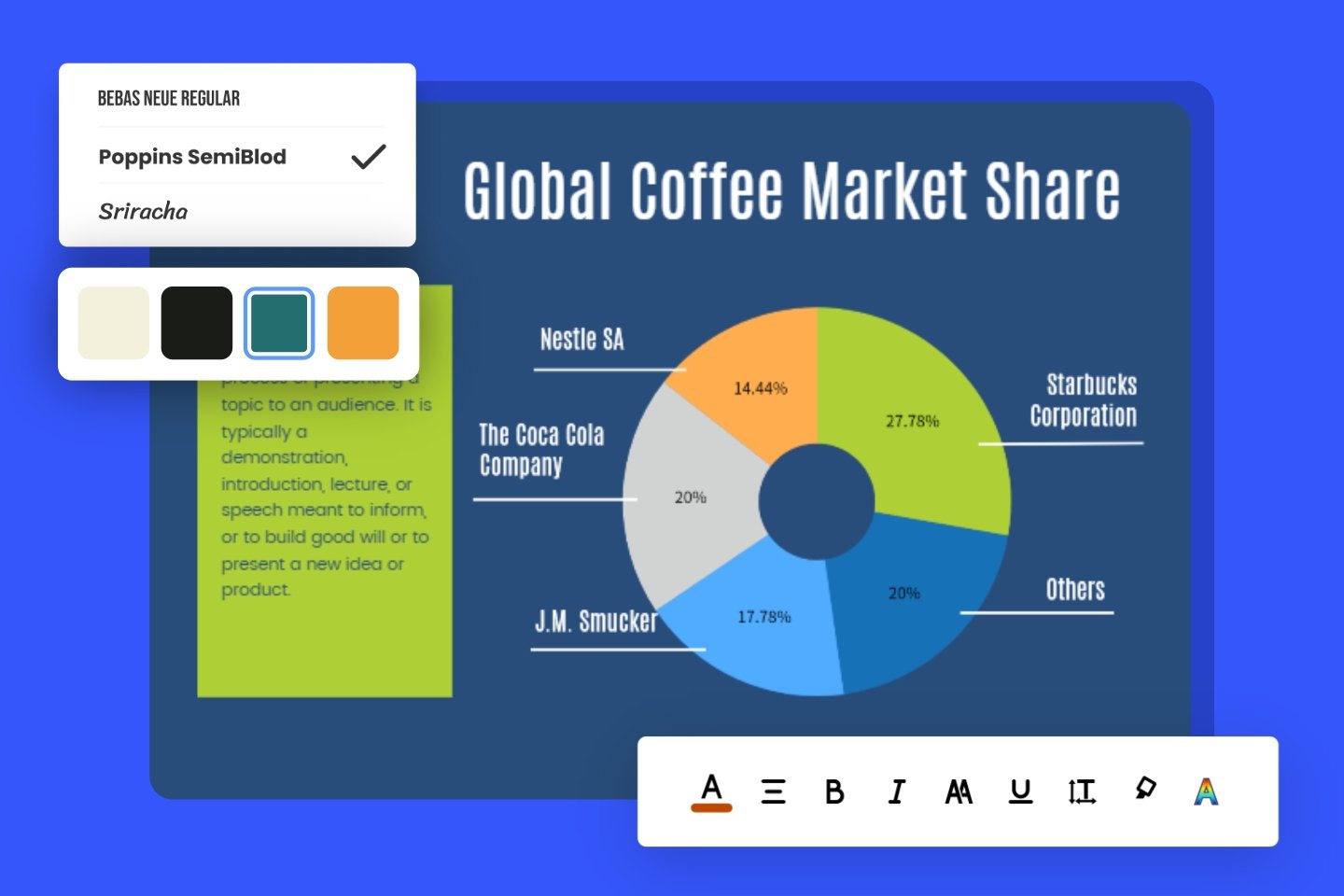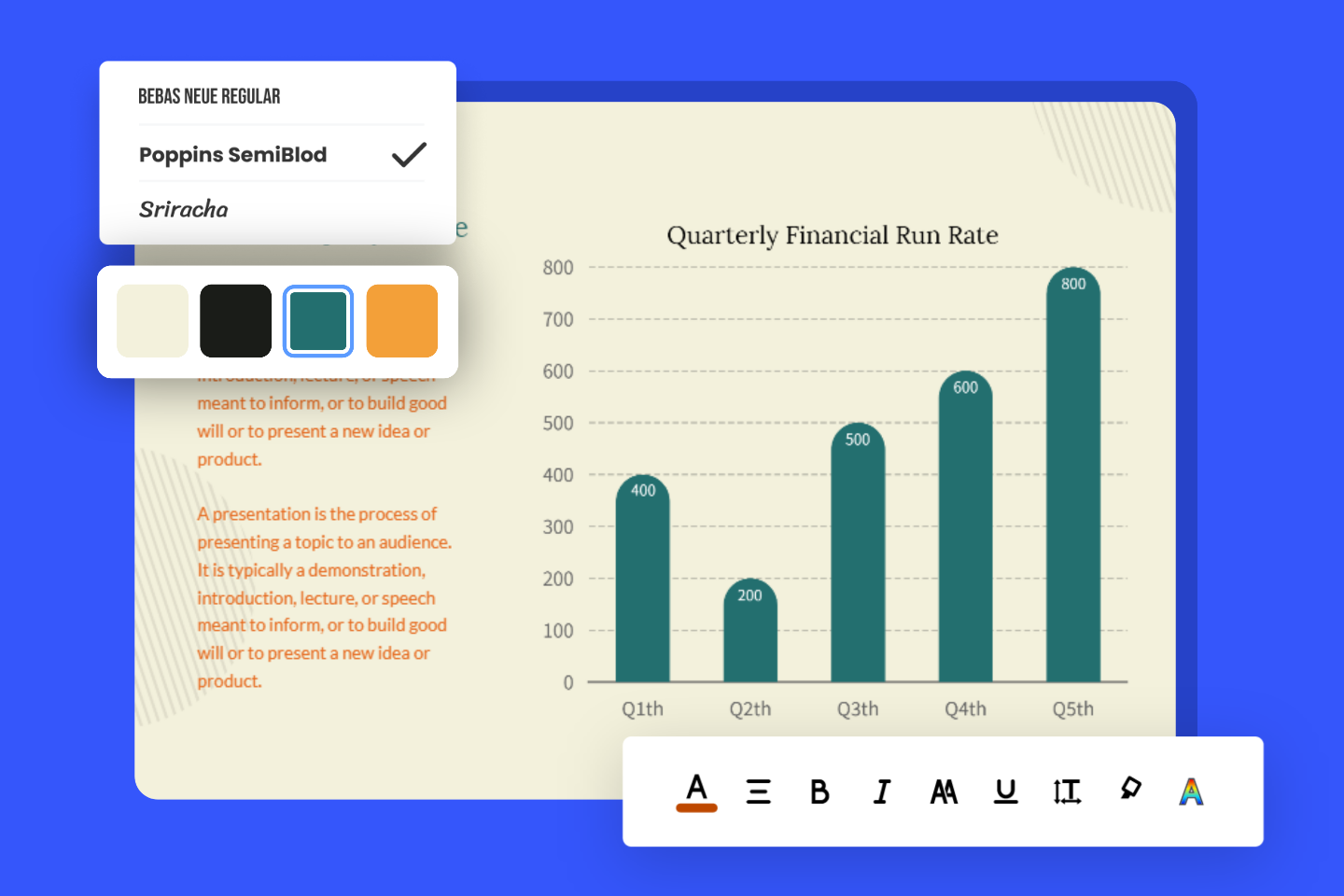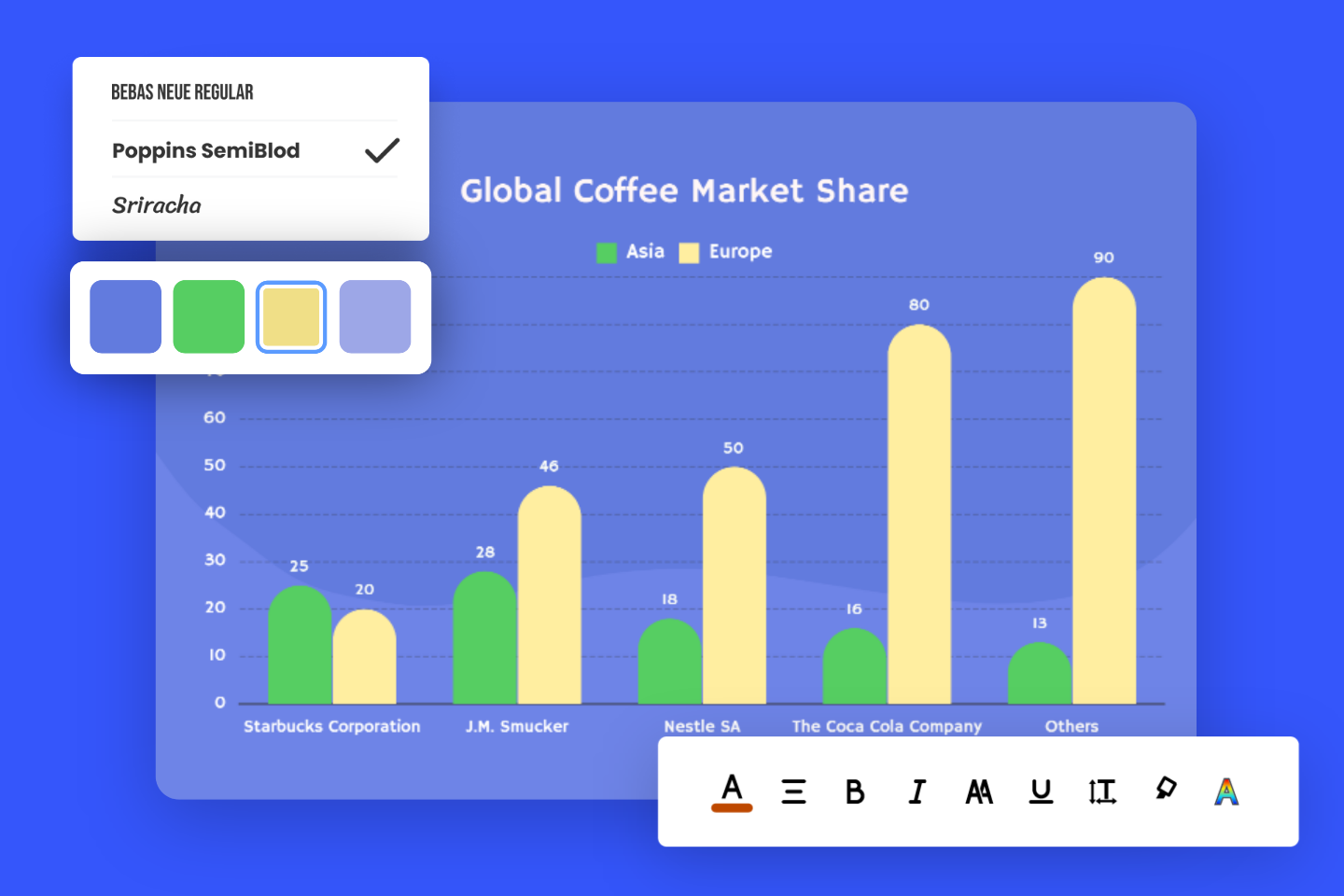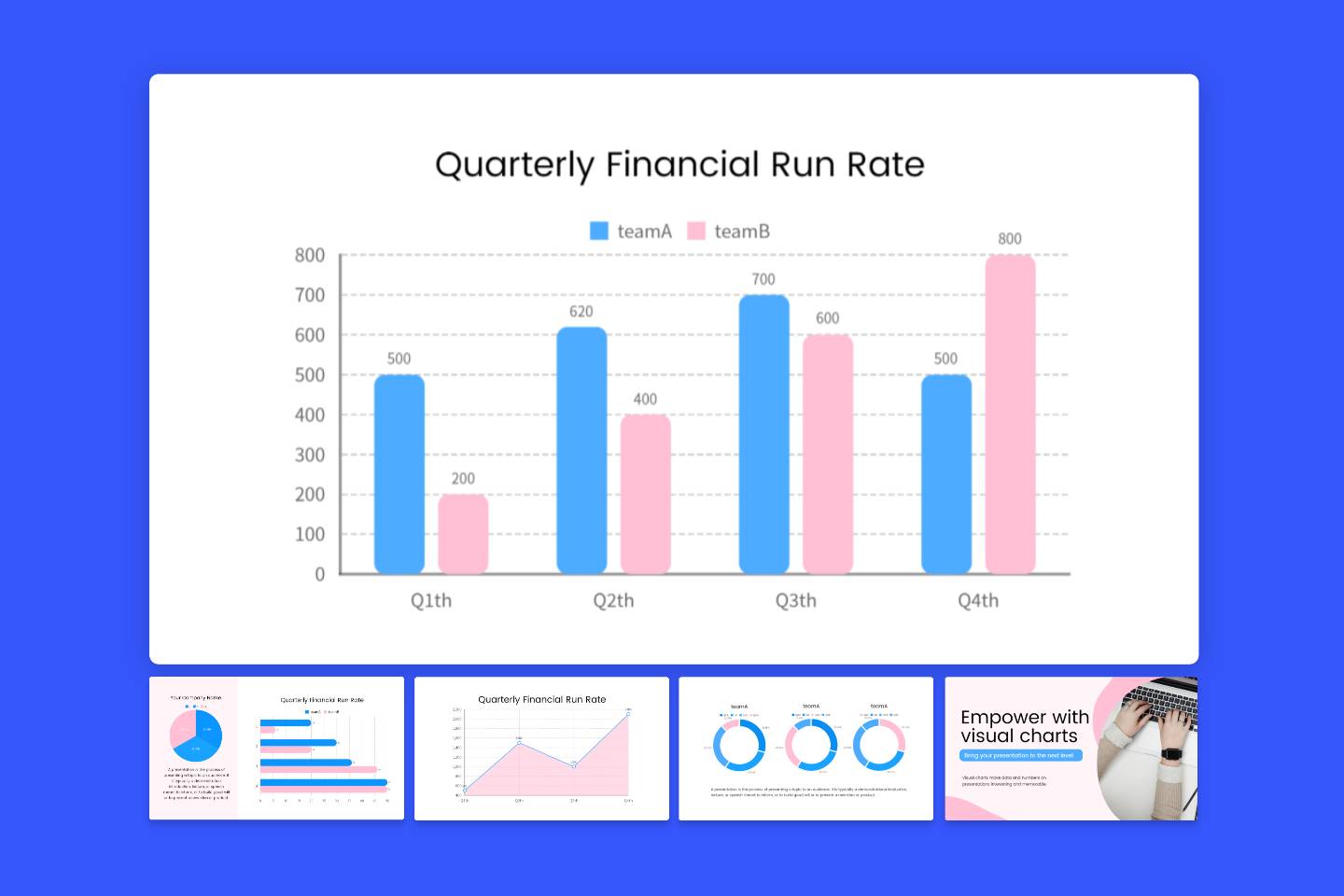20 Major Types of Graphs & Charts: Their Features, Applicable, and Limitations

With the development of the times, more and more data volume accumulates. However, the dense data is less readable and pointless.
Data visualization can make data changes more intuitive and meaningful and can help people understand and accept data. Therefore, it is very important to use appropriate graphs to visualize data.
This article will introduce 20 commonly used graph types in turn, analyze their characteristics, applicable scenarios, and limitations, so as to help you convey the information expressed through charts more intuitively.
Column Chart
A column chart is a statistical graph that expresses a graph with the length of a rectangle as a variable. It is represented by a series of vertical stripes of varying heights that represent the distribution of data. Used to compare the relationship of two or more variables. Column charts are useful for comparing discrete data or showing trends over time.
Features:
- Visually see the size of each data.
- Show data changes for multiple categories and comparisons between variables in the same category.
Applicable: Compare categorical data.
Limitation: Too many categories cannot display data characteristics.
Similar charts:
1) Stacked column chart. Compare the difference between the variables of the same category and the sum of variables of different categories.
2) Percent stacked column chart. Fit to show the proportion of each variable in the same category.
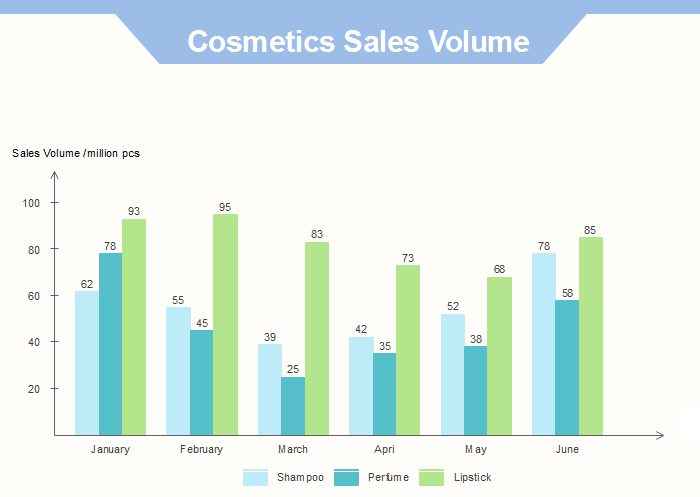
1. Grouped Column Chart
A grouped column chart is also called an aggregated column graph. When users need to display different groups under each category on the same axis, they need to use a grouped column chart.
Similar to a column chart, the height of the columns is used to map and compare data values. The columns in each group use different colors or the same color with different transparency to distinguish each category. And each group needs to be spaced apart. Grouped column graphs are often used to compare data between different groups, which all contain the same category of data.
2. Stacked Column Chart
It is often used to compare values of different categories. Moreover, each of its values is divided into multiple sub-categories, and these sub-categories are generally referred to by different colors.
If a column graph can help us observe the "total", then the stacked bar chart can reflect the "total" and "structure" at the same time. Further, we can also explore which part has the largest proportion, and how each part changes.
3. Percent Stacked Column Chart
Each column is of equal length and totals 100%.
The interior of the column is divided into sections, the height of which is determined as a percentage of the total. Therefore, unlike a normal column graph or a stacked column graph, a 100% stacked column chart does not show the "absolute value" of the data, but rather a "relative scale".
But at the same time, it still has the inherent function of the histogram, that is, "comparison". We can analyze the relative difference between the values by comparing the composition of multiple columns or drawing the trend of the value change.
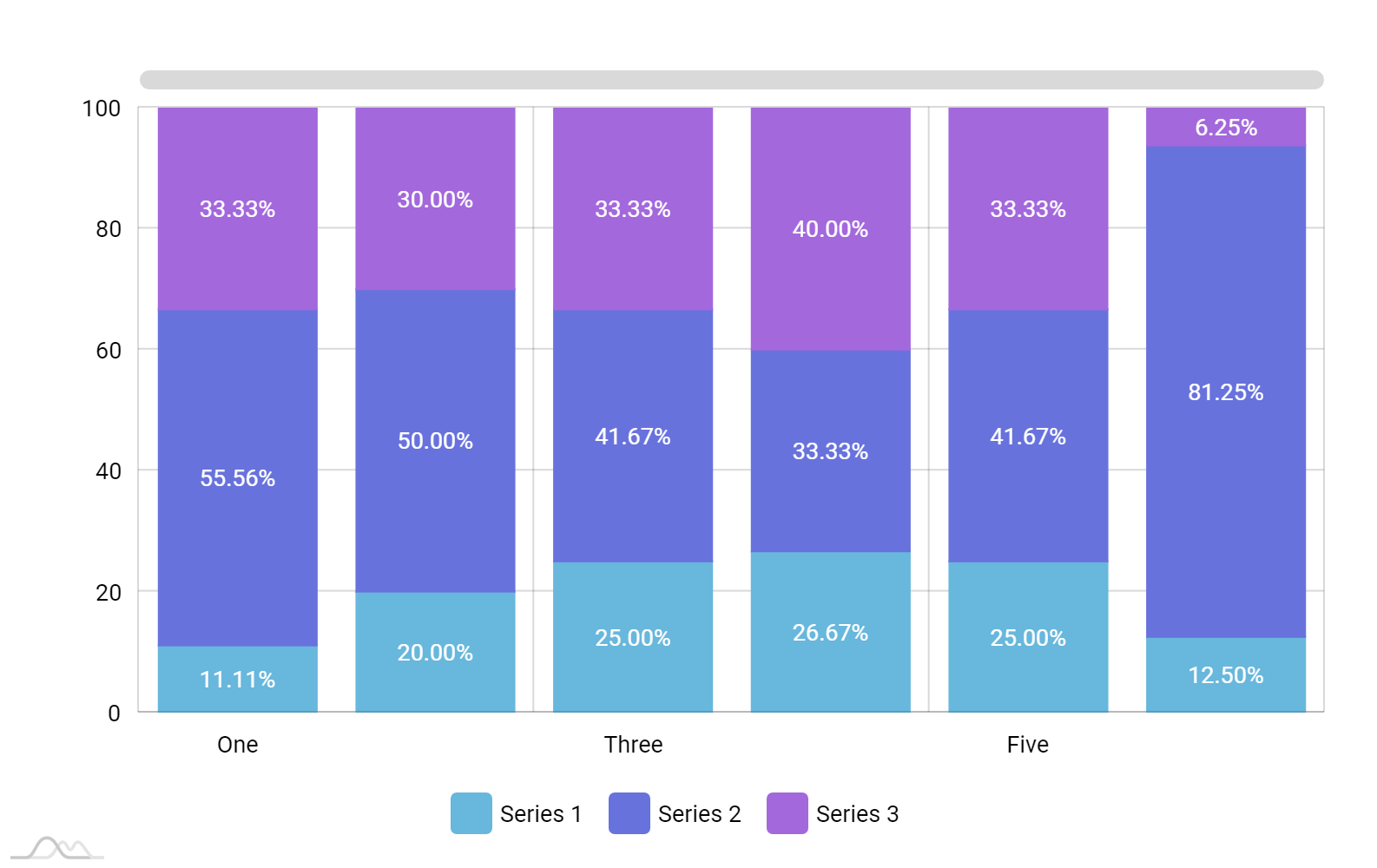
Bar Chart
The bar chart uses the length of each strip to represent a certain quantity and generates straight bars of different lengths according to the numerical value of the classification. Which is used to summarize and compare the classification data. Through such numerical expressions, the relative differences between categorical values can be intuitively understood.
Features:
- Useful for showing trends over time and plotting multiple data series.
- It is easy to see the size of the value according to the length of the column and to compare the differences between groups of data
- Use horizontal data markers to compare individual values.
Applicable: Visually represent the size of the data volume and compare
Limitations: Too many categories will not be able to display data characteristics.
Similar charts:
1) Stacked bar chart. Compare the difference between the variables of the same category and the sum of variables of different categories.
2) Percent Stacked Bar Chart. Fit to show the proportion of each variable in the same category.
3) Bidirectional histogram. Compare the positive and negative numerical differences of the same category.

Histogram
A histogram, also known as a mass distribution diagram, is a graph used to represent the frequency distribution of several data points of a variable. It represents the distribution of data by a series of vertical stripes or line segments of varying heights. Generally, the horizontal axis represents the data type, and the vertical axis represents the distribution.
A histogram typically categorizes data into various "bins" or "range groups" and counts the number of data points that belong to each bin.
Features:
- Easy to show differences in frequency between groups.
- Can analyze how process results change over time.
Applicable: Analyze the frequency distribution of sample data.
Limitations: Indiscriminate data processing, some information may be lost.

Line Graph
A line graph is a statistical graph in which the rise or fall of the broken line represents the increase or decrease of the statistical quantity. Compared with the bar chart, the line chart can not only represent the quantity but also reflect the development and changes of the same thing at different times.
Features: It can display the trend of data changes and reflect the changes in things.
Applicable: Ordered categories, such as time.
Limitations:
- Unordered categories cannot show data characteristics.
- It is best not to use stacked line graphs, as they are difficult to distinguish from non-stacked line charts that use multiple data series.
Similar charts:
1) Area chart. Displays the magnitude of the value in terms of area. Trends in the number of impressions over time.
2) Stacked area chart. The difference between the variables of the same category and the sum of variables of different categories.
3) Percent stacked area chart. Compare the difference in proportions of each variable in the same category.
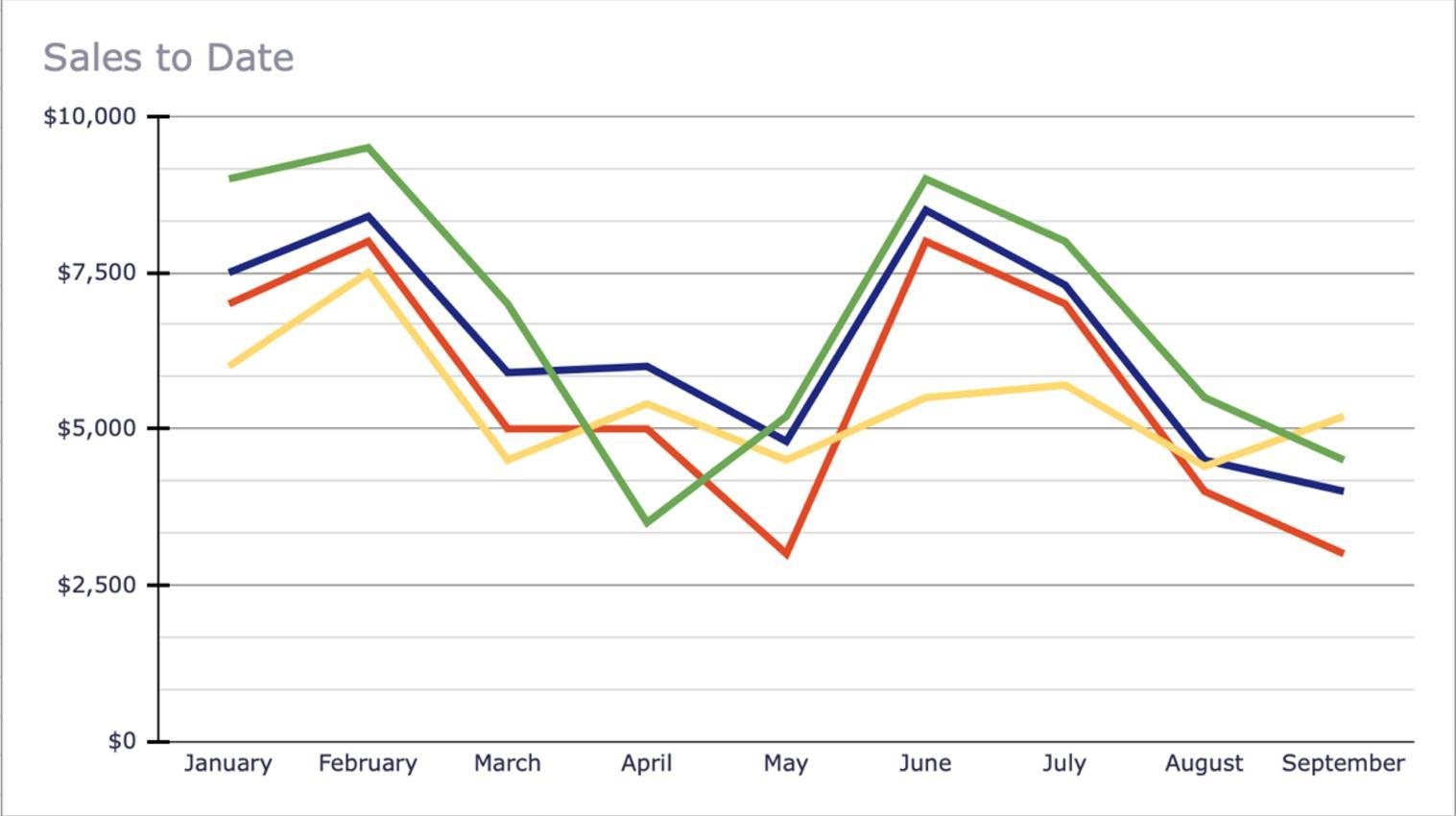
Area Chart
An area chart is a statistical chart that reflects changes in numerical values with the change of an ordinal variable. It emphasizes the rate at which quantities change over time and can also be used to draw attention to trends in aggregate values.
When the user needs to establish the relationship between the whole and the part, that is, when there is a summation relationship between the classified data, the relationship between the data can be found intuitively.
Features:
- The area between the polyline and the independent variable axis will be filled with color or texture.
- Not only can it clearly reflect the trend changes of the data, but also can emphasize the gap comparison between different types of data
Applicable:
- Reflect the trend change of one or more sets of data and the comparison with each other under the continuous independent variable.
- Observe the changing trend of the total amount of data.
- Limitations: The filling will make the shapes cover each other and make the changes invisible.
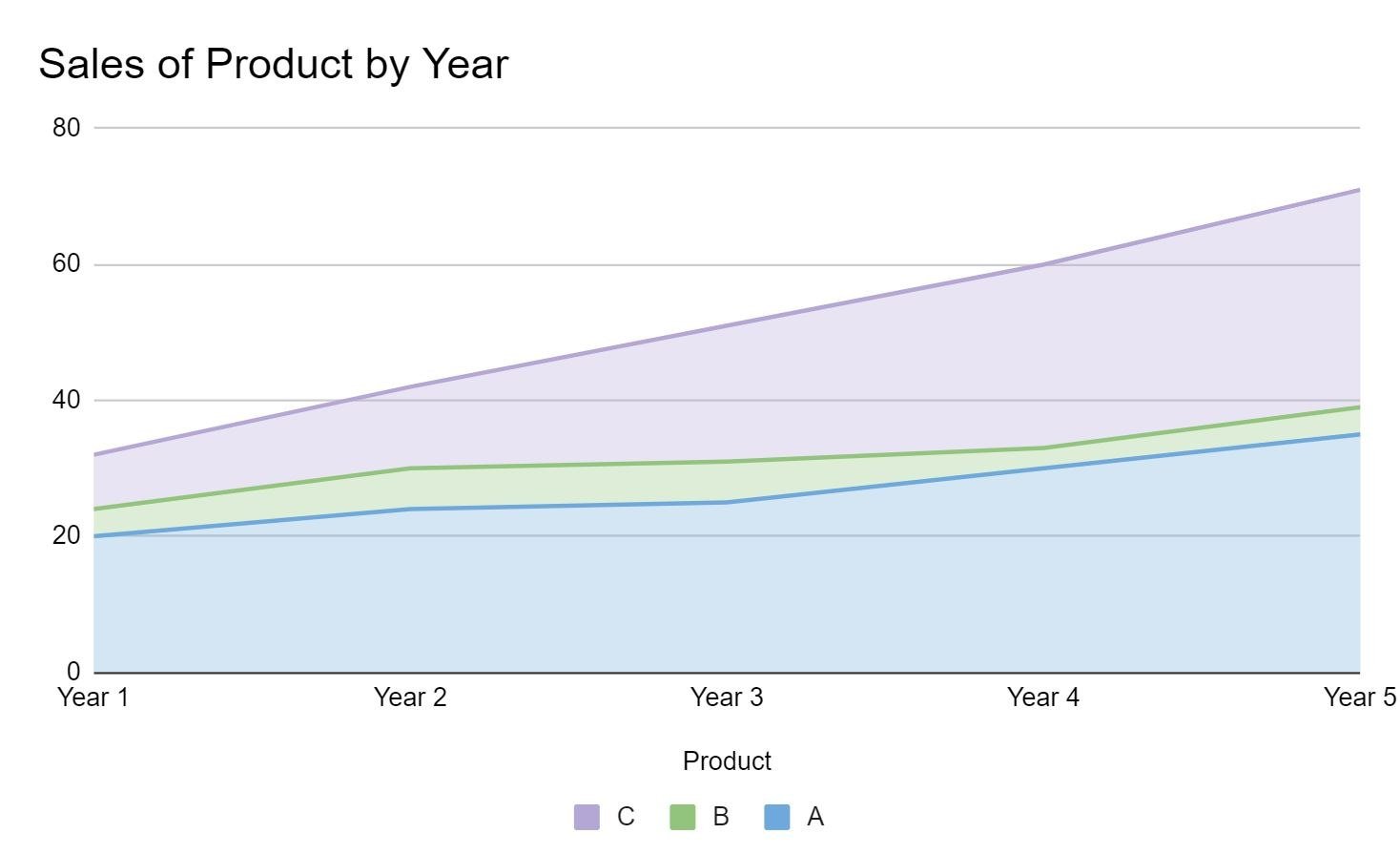
Pie Chart
A pie chart consists of a circle that is divided into two or more sectors. Pie graphs emphasize the relative relationship between data and the whole. And it is especially useful for showing proportions and ratios.
The pie chart is often used to express the percentage of a part of a population. It is easy to reflect the quantitative relationship between part and part, part and whole.
Features:
- Very useful for highlighting scale.
- Show the relationship between the part and the whole.
- A single data series can be plotted.
Applicable: Understand the distribution of data.
Limitations: If there are too many categories, the smaller the sector is, the chart cannot be displayed.
When using, pay attention to the following:
It must be confirmed that the sum of the data of each sector is equal to 100%;
Avoid more than 5 sectors, and try to keep the chart concise and clear;
Pay attention to the arrangement order of the fan shapes. Under normal circumstances, place the largest fan shape in the 12 o'clock direction, and then arrange it in order by area;
Finally, the correct use of color can distinguish the scallops that need to be emphasized without dazzling people.
Similar graphs:
1) Ring diagram. It is a hollowed-out pie chart. The middle area can display data or text information.
2) Rose pie graph. Compare the magnitudes of different categories.
3) Sunburst map. Show the proportion of various categories of data at the parent-child level.

Doughnut Graph
A doughnut chart is similar to a pie chart in that it shows the relationship between the parts and the whole. It usually shows the proportion of categorical data. The size of each part of the ring represents the proportion of each category. Each slice of the doughnut graph represents a different block of data, usually color-coded for easy understanding.
A doughnut chart has two dimensions, so it requires two sets of information that have a common relationship. The first dimension represents the attribute, and the second dimension represents the attribute value.
Features:
- Be more interactive and make richer data available to readers.
- Space within a doughnut chart can be used to represent data, labels, etc., making it easier to read the chart.
Applicable: Show the proportion of categorical data.
Limitations: Too many segments. Each segment is only a small fraction of the total data, and the segments may be difficult to read.
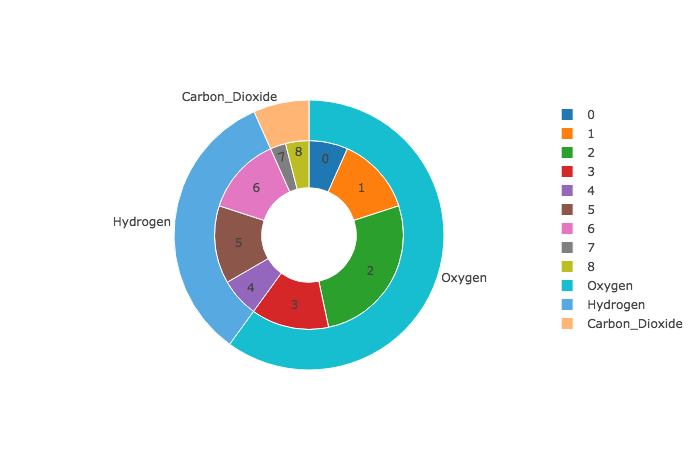
Sunburst Chart
A sunburst graph is a chart that presents hierarchical data. It displays data in a parent-child hierarchy and forms a concentric circle, so it is also called a multi-layer pie chart. The closer to the origin, the higher the level of data.
The essence of the sunburst diagram is a tree-like relationship, which is equivalent to a tree diagram, so it is also called a rectangular tree diagram in polar coordinates. It can clearly display the structural relationship between data while carrying a large amount of data.
Features:
- Clearly show the relationship between different levels of data.
- More subdivided traceability, truly understanding the specific composition of the data.
Applicable: suitable for representing data with multiple levels.
Limitations: If there are too many layers without interaction, it will cause great difficulty in reading.
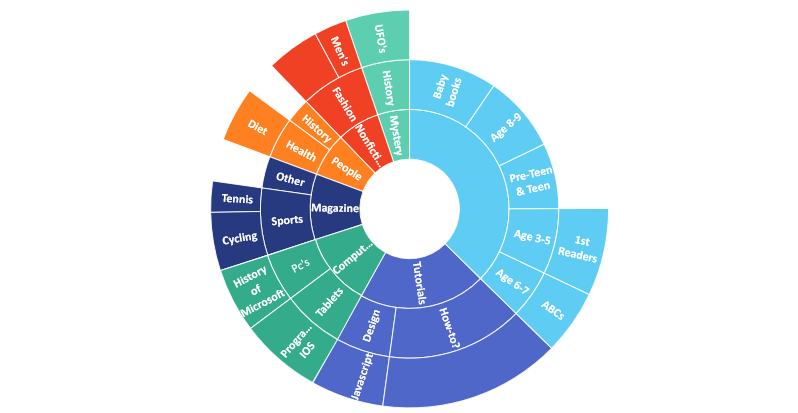
Nightingale Rose Chart
Also known as the cockscomb diagram and polar diagram, it is a circular histogram.
Nightingale rose charts are drawn on a polar coordinate system. Each data class or interval is divided into equal segments on the radial graph, and how far each segment extends from the center (in proportion to the value it represents) depends on the polar axis. Therefore, each ring extending from the center of the polar coordinates can be used as a ruler to indicate segment size and to represent higher values. In the Nightingale rose graph, the value is represented by the area of the segment, not its radius.
Features:
- Use the radius to reflect the value.
- Use values and angles to display information as a circular chart in polar coordinates.
Applicable: Display scientific computing data.
Limitations: Larger peripheral parts will be more noticeable, which is inversely proportional to the increment of the value.
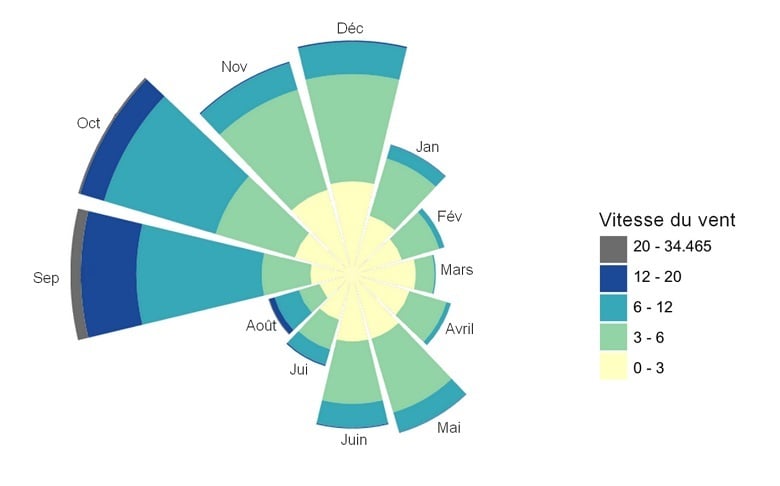
Combination Graph
Combination charts plot multiple data series by using a combination of column, area, and line charts within a single chart. Combination charts are useful for highlighting relationships between various data series.
Features:
- A chart form that combines two or more charts.
- Can answer questions about the data.
Applicable: Have two different datasets with common string fields.
Limitations:
- When too many dimensions of data are concentrated in the combination chart, the chart will be overcrowded.
- The increase of indicators will interfere with decision makers' inability to grasp the data to mainly convey information.
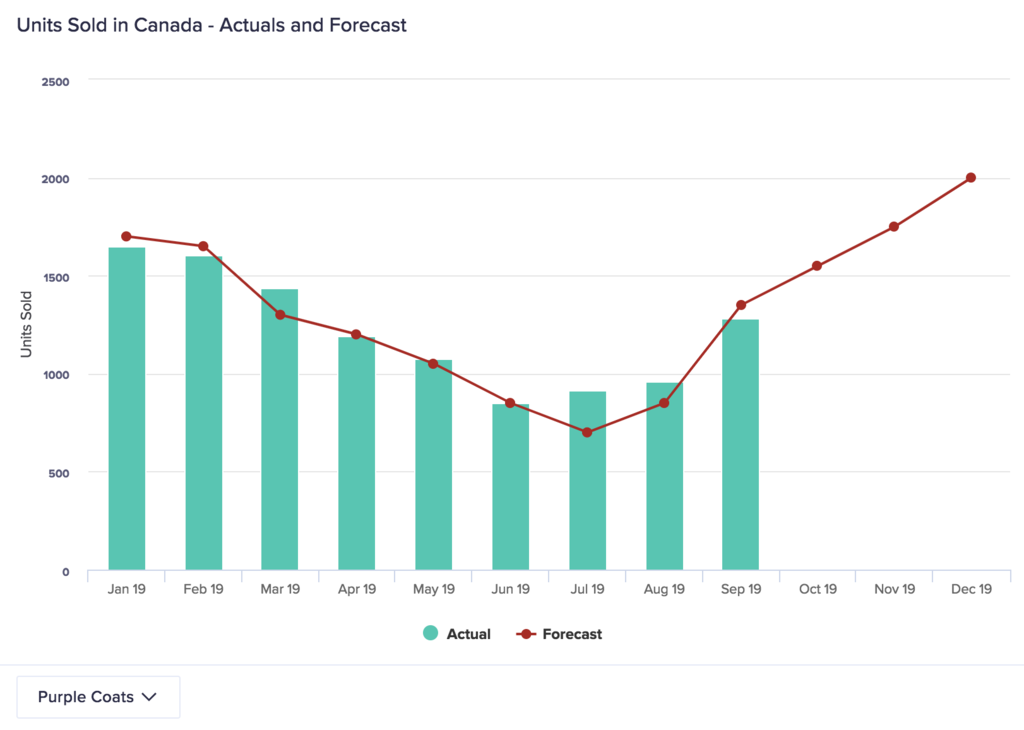
Scatter Chart
Scatter charts use data values as x, and y coordinates to draw points. It can reveal relationships between values plotted on the grid and also show trends in the data.
Scatter graphs are useful for representing the relationship between two variables, how they are distributed, and for finding outliers based on how they are distributed.
Features:
- Very useful for exploring the interrelationships between different datasets.
- Used to discover relationships between variables.
Applicable: With a large number of data points, the results are more accurate, such as regression analysis.
Limitation: When the amount of data is small, it will be more confusing.
Similar charts:
Bubble chart. Use bubbles to replace the numerical points of the scatter plot, and the size of the area represents the size of the numerical value.
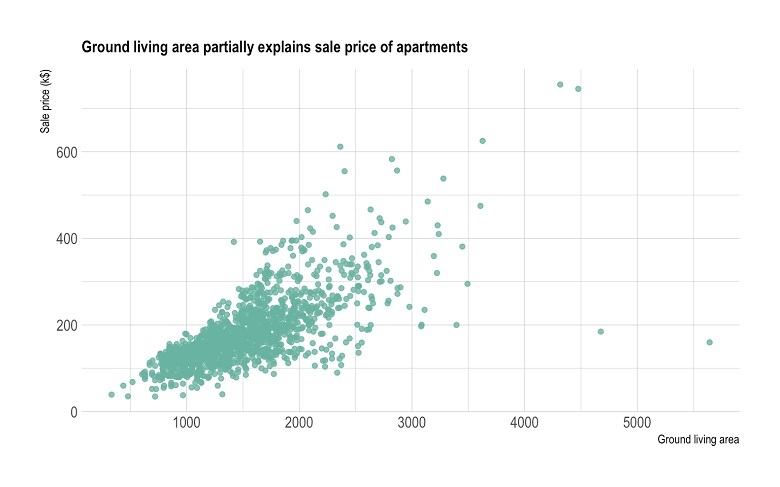
Bubble Chart
A bubble graph can be used to show the relationship between three variables. It is similar to a scatter plot, plotting one variable on the horizontal axis, another on the vertical axis, and a third variable represented by the size of the bubbles.
Using bubble charts, you can display the relationship between values in several data series. Similar to the XY axis, it determines whether there is a certain relationship between two variables, or finds the distribution or aggregation of data.
Features:
- Intuitively show the overall relationship trend between influencing factors and predicted objects.
- It can reflect the morphological change relationship between variables through intuitive and eye-catching graphics, so as to simulate the relationship between variables.
Applicable: Commonly used to view the association method of categorical data.
Limitations:
- The bubble chart looks messy. Basically, only correlation, distribution, and aggregation can be seen, and other information cannot be well displayed.
- Bubble charts need to have enough data points and correlations between the data to show good results.
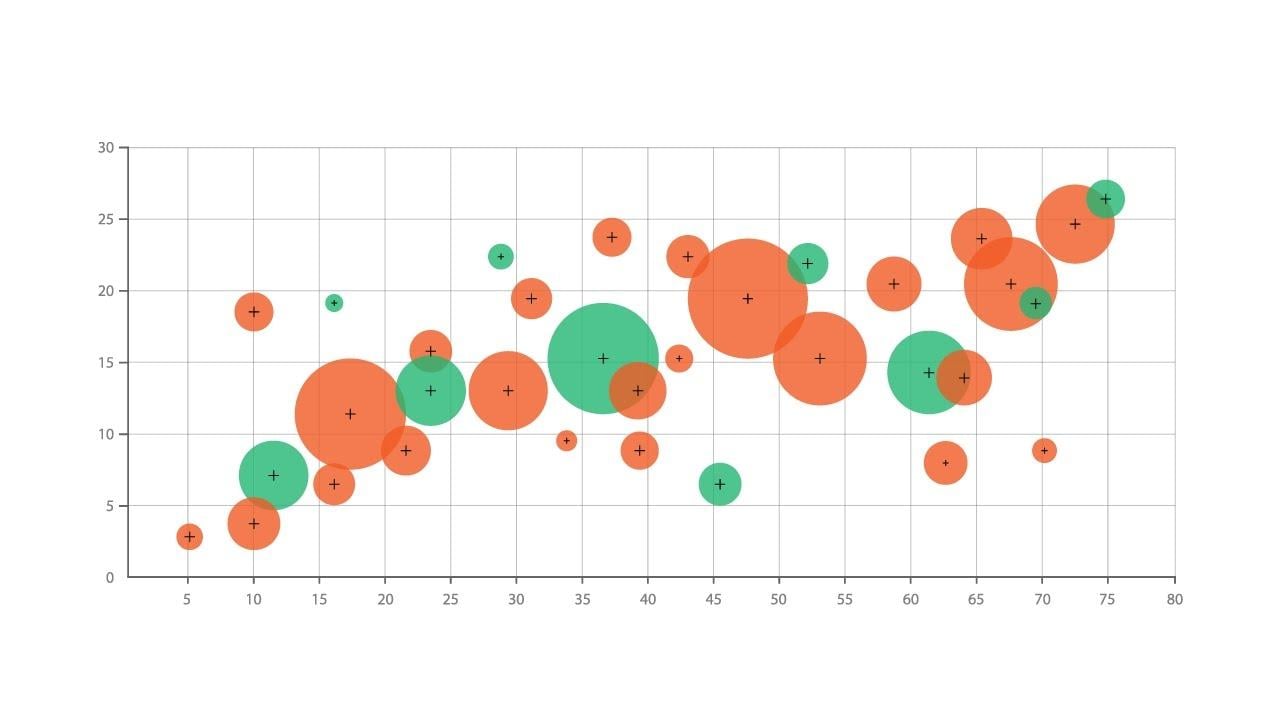
Dashboard Chart
Dashboard graphs, also known as dial charts or speedometer charts, use needles to display information as readings on a dial.
Dashboard charts consist of dashboard axes (with data ranges, color ranges, and interval markers), pointers, and a central pivot point. On a dashboard graph, the value of each pointer is read against a colored data range or chart axis. This chart type is often used to execute dashboard reports to display key business indicators.
Features:
Intuitively show the progress and completion of a certain indicator, mainly used for the display of progress or proportion.
Dashboard charts are useful for comparing values between a small number of variables, using multiple pointers on the same dashboard, or using multiple dashboards.
Suitable for: Showing project progress.
Limitations:
- It is only suitable for showing the accumulation of data, not for the distribution characteristics of data.
- Only one indicator data can be displayed, and the displayed information is limited.
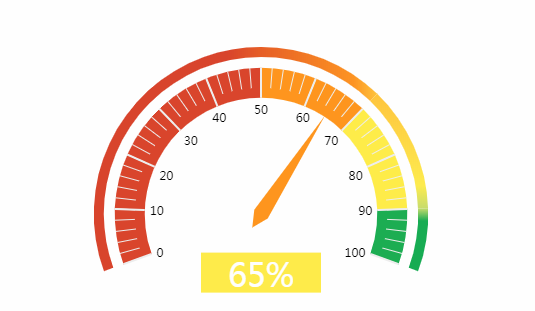
Radar Graph
A radar chart is a graphical method of displaying multivariate data. It combines multiple axes into a radial figure. For each number, the data is plotted along a separate axis from the center of the graph. Map the data volume of multiple categories to the coordinate axis, and compare the characteristics of different attributes of an item.
In addition, the comparison of the overall numerical conditions can also be performed between multiple radar charts or between the multi-layer data lines of the radar charts.
Features:
- Shows comparisons of variables for categories (items) with three or more dimensions.
- Shows differences in variables across multiple dimensions for different categories (items).
Applicable: Understand the comprehensive situation of different attributes of the same category, and compare the differences of the same attribute in different categories.
Limitations: There are too many categories or too many variables, which will be confusing.
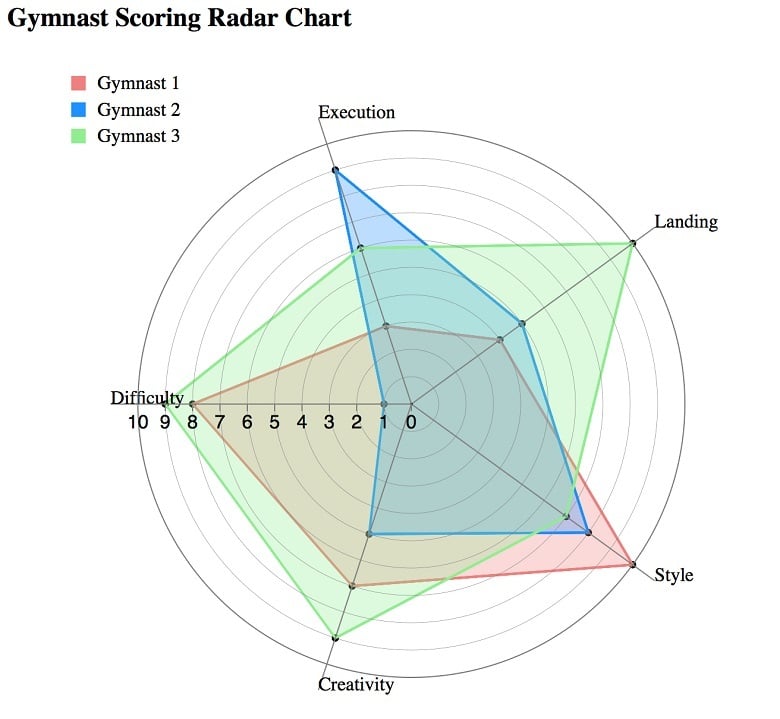
Heatmap
The heatmap mainly expresses the magnitude of the value (two dimensions) through color and is generally used to reflect the degree of activity. Data-intensive situations are clearly visible. Useful for viewing populations, spotting outliers, showing differences between multiple variables, and detecting any correlations between them.
Features:
- Graphically highlight areas of the page that visitors are most interested in and the geographic areas where the visitor is located.
- When drawing, you need to specify the rules for color mapping.
Applicable: You can clearly see the visitor's focus of interest in every area of the page.
Limitations: Not applicable for numeric fields that are summary values and require a continuous numeric data distribution.

Rectangular Tree Diagram
A rectangular tree diagram is a rectangular tree structure diagram that can intuitively represent the size and proportion of data. It consists of multiple arrays of rectangles and shows the hierarchy of the data.
A treemap uses rectangles to represent nodes in a hierarchy. The hierarchical relationship between parent and child nodes is expressed by the mutual nesting metaphor between rectangles. Starting from the root node, the screen space is divided into multiple rectangles according to the corresponding number of child nodes. And the area size of the rectangle usually corresponds to the attributes of the nodes.
Features:
- Show different categories of the same level and the proportion of children under the same category.
- More efficient use of space.
Applicable: Tree data showing the proportion of parent and child levels.
Limitations:
- It is not suitable for displaying data at different levels, such as organizational charts.
- It is not suitable to put each category together to see the proportion.
- Not suitable for displaying data with a small proportion of categories.
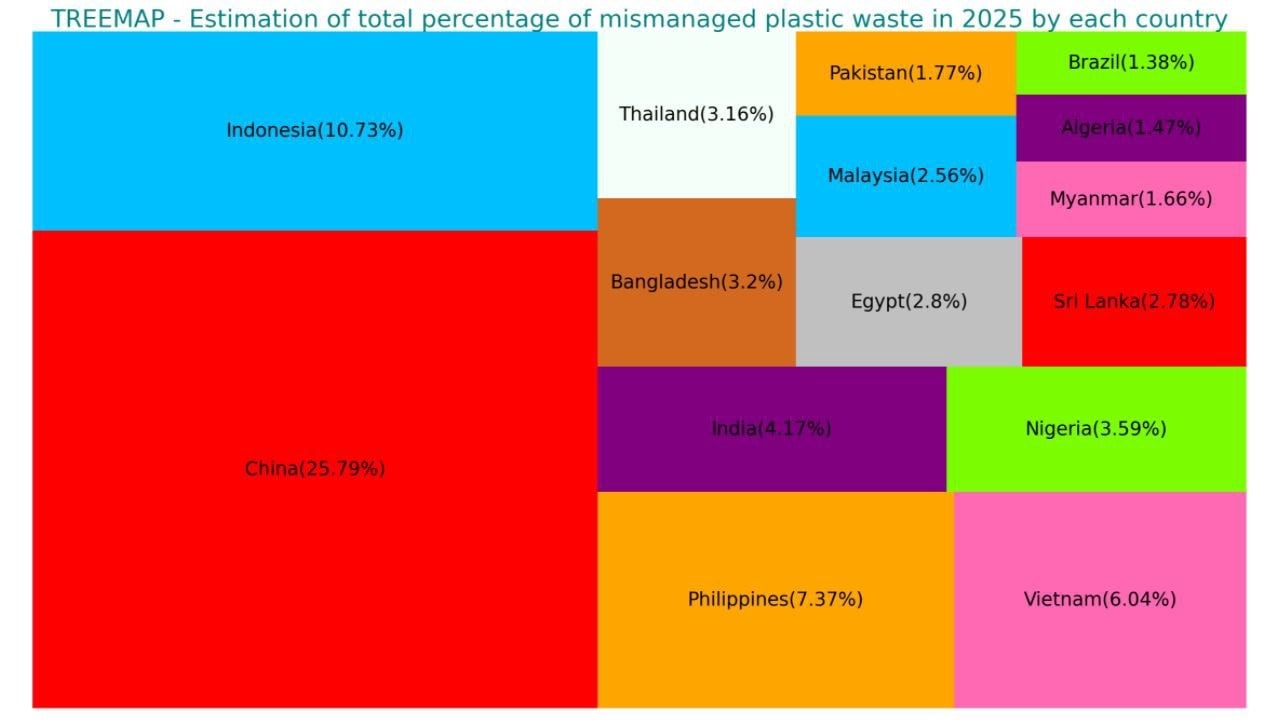
Funnel Graph
A funnel graph is used for single-pass analysis. It consists of N process links between the start and the end.
Funnel charts are best used to show the progress of business processes, such as user conversions. Through the funnel chart, you can intuitively see the proportion of each part in the process, discover problems in the process, and then make decisions.
The starting point of the funnel graph is always 100%, and it decreases in turn in each link, and each link has a logical sequence relationship.
Features: Use the trapezoidal area to represent the difference between the business volume of a certain link and the previous link.
Applicable: Analysis with a fixed process and many links can visually display the conversion rate and churn rate.
Limitations: Unordered categories or variables with no process relationship.

Waterfall Chart
Waterfall charts are also known as flying brick charts, bridge charts, and Mario charts because they resemble the blocks hanging in the air in popular computer games.
It shows how the initial value is affected by the cumulative effect of successive positive and negative values. This chart can be used to display ordinal or categorical data.
Features:
The combination of absolute value and relative value is used to display the distribution and composition of each component, such as the proportion of various living expenses.
Applicable: Shows the cumulative change process of the data.
Limitation: Data of various categories are too different to be compared.
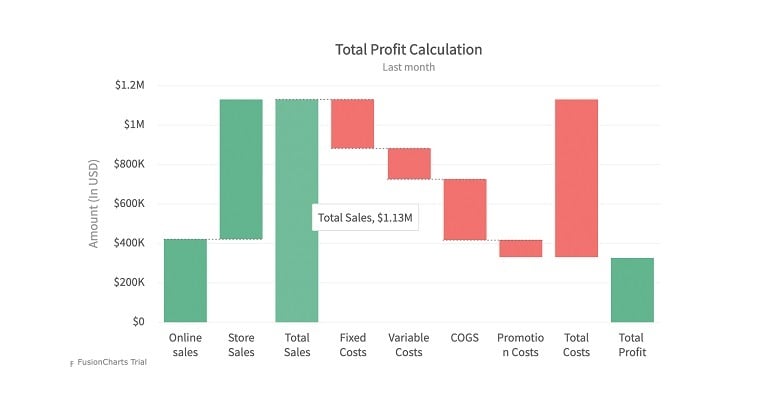
Sankey diagram
Sankey diagram, that is, the Sankey energy split diagram, also known as the Sankey energy balance diagram. It is a specific type of flowchart. The width of the extended branch in the figure corresponds to the size of the data traffic, and the sum of the starting traffic is always balanced with the sum of the ending traffic. It is usually applied to the visual analysis of energy, material composition, financial and other data.
Features:
For visualizing energy or cost shifting.
The total value of the Sankey diagram remains the same, adhering to the "energy conservation" of the data.
Applicable: used to indicate the flow of data.
Limitation: Not applicable to scenarios with different starting and ending traffic. Such as the use of mobile phone brand changes.
Similar diagrams:
Chord diagrams. Show the relationship between the data in the matrix and the flow changes. Not applicable if there are too many data nodes.
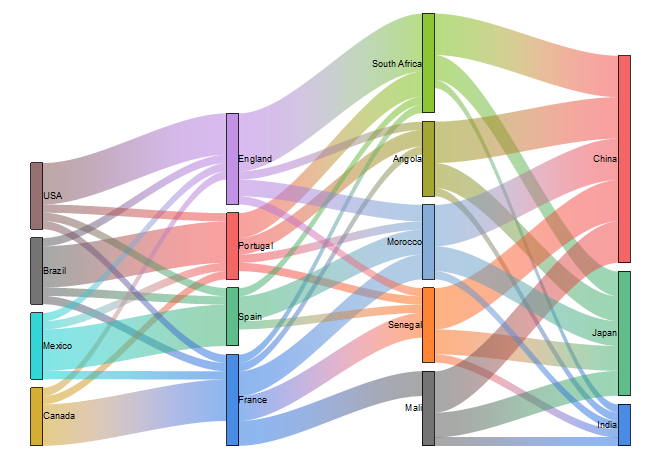
Summing Up
The above are the main features, limitations, and applications of the 20 graphs and charts. Use an online chart maker to create any type of chart in minutes. Quick, easy, and free to use. Hope those graphs can help you better visualize the data and grasp more information hidden in the data.





